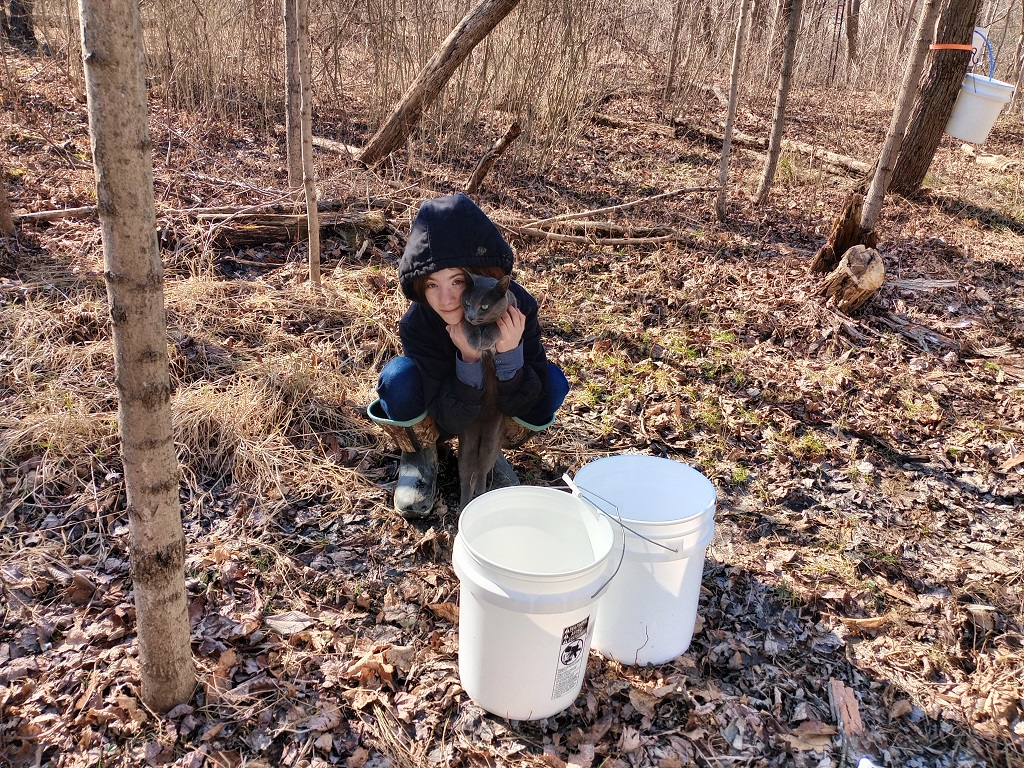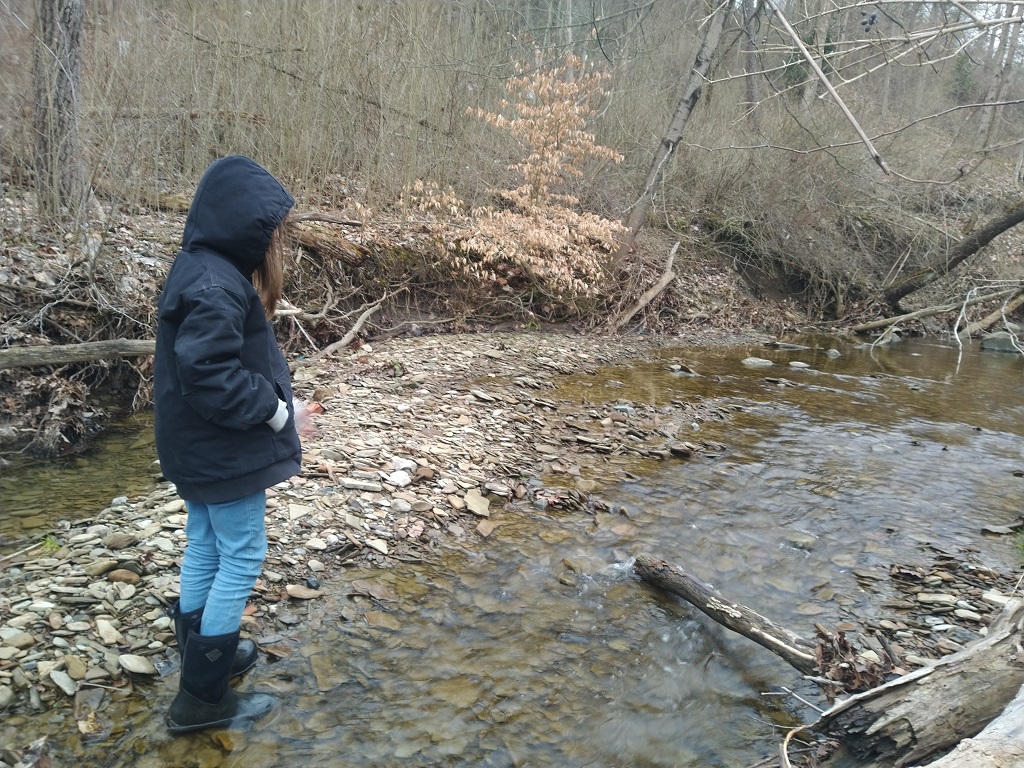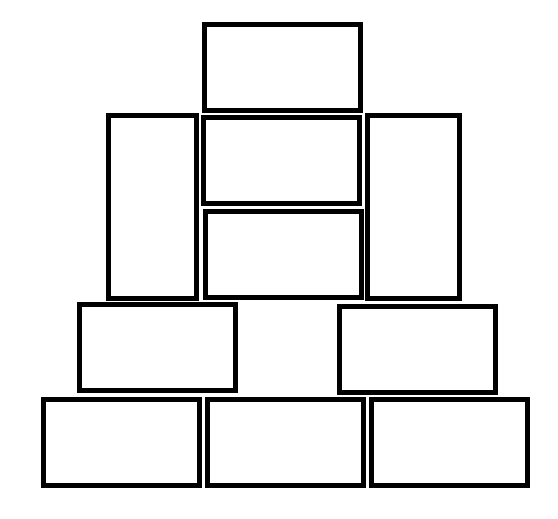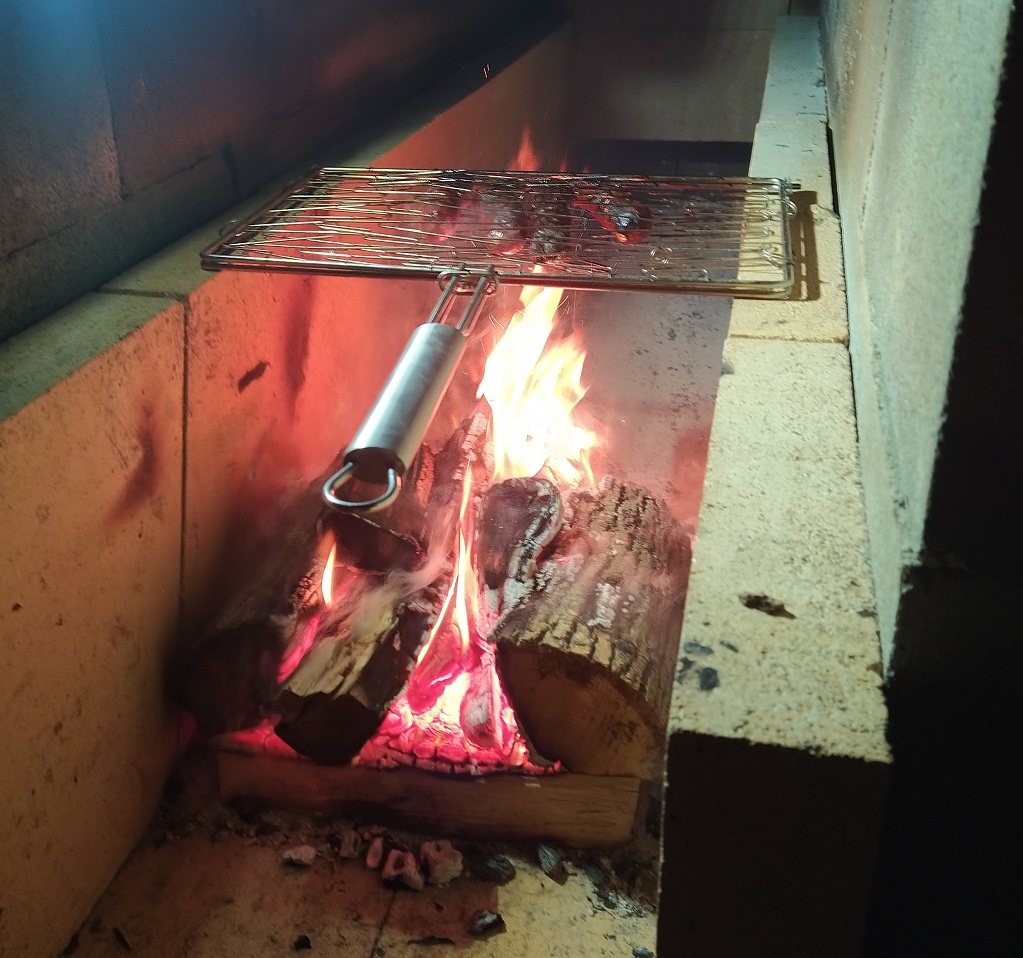We started collecting our maple sap — somewhere around 80 gallons of sap which will make 2 gallons of syrup. This is the first year we had kitten helpers – they were rather puzzled by the ratchet straps and buckets on the trees, but they enjoyed that we were playing in the woods with them. Even if they couldn’t figure out what our game was.
Category: Maple Sugaring
2024 Maple Season: Tree Tapping
We’ve got 43 maple trees and two black walnut trees tapped. 18 maples were tapped yesterday in the back woods (plus the one right by the driveway).
The big maple by the river, that I’ve been waiting to tap since we found it … had nothing! Hopefully sap starts flowing there too. The other trees, though, were drip, drip, dripping steadily
2023 Maple Season – Wrap up
A total of about 6 gallons of syrup this year — 3.5 gallons on the 6th of March and another 2.5 gallons on the 5th of April. We tapped 39 trees (some with two taps — we need to log the type of tree & how many taps get put in!) including some on the new farm land.
River Walk
Maple log — finishing boil
We used our DigiBoil 65L 240V pot to finish the sap since it’s quick to remove from the heat once the syrup is ready (and it’s got a spigot that makes emptying the pot easier). This also gave us a good picture of how long the DigiBoil is going to take to boil wort when we’re making beer. Yesterday, with temps in the upper 30’s, it took about 1h50m (basically two hours) to boil 10 gallons of concentrated sap. Today, with temps in the upper 40’s, it took about 50 minutes to boil 7 gallons of concentrated sap.
Sunday 05 March 2023
15:44 59F
16:40 167F
17:17 203F
17:34 208F and rapidly boiling
1h50m to boil.
Flamed out just after midnight
Monday 06 March 2023
09:43AM – 68F turned on 500W
09:50AM – Turned on 2nd switch
09:56AM – 111F – turned on 3rd switch
10:32AM – 7 gallons is now boiling
About 50 minutes to boil.
Maple flame out at 2:34PM
Bottled, we have 3.5 gallons of maple syrup from our first run
Mid-Season Maple Collection Status
So far, we’ve collected about 121 gallons of maple sap. We started boiling the sap on the 23rd using our new maple evaporator.
Maple Sap Collection Log
| Date | Location | Quantity |
| 2/14/2023 | All trees except river | 60 |
| 2/18/2023 | All trees except river | 20 |
| 2/23/2023 | All trees except river | 15 |
| 2/25/2023 | River | 6 |
| 2/26/2023 | Back woods and front yard | 12 |
| 2/26/2023 | Top of Driveway – east and west | 8 |
Gathering sap … and moss!
Maple Evaporator Build
We built our maple evaporator — well, combination fire table, maple evaporator, grill, and smoker all-in-one backyard fire contraption. Scott calls it the MapleAtor. Total cost was about a hundred bucks — $60 for refractory brick, about $10 for the cinder blocks, and about $30 for “engineering” size brick (and probably another hundred bucks in fuel to *get* the blocks and refractory brick!).
We’ve got a layer of cinder blocks on the base — four rows five blocks long. Since we had four half-blocks, we were able to stagger the walls. Nothing is mortared together yet — we wanted to make sure it was a good size, shape, and location before we made anything permanent.
Two rows of fire brick lay atop the cinder blocks — we wanted to be able to set the 6″ steam table trays that we use to evaporate sap onto the cinder blocks and seal the fire section in so the syrup doesn’t get smoked as we evaporate it. The dimensions didn’t quite line up — we needed something 2 3/4″ high to fill in the gap between the edge of the refractory brick and the edge of the cinder block. I happened across “engineering” bricks online, and we found a company that sold them. They fit perfectly.
Once the base layer was covered in refractory brick and red brick, we started stacking the walls — more cinder blocks.
Along the back wall, we have some bricks forming a wall, but we have one row slightly pushed in so a block can straddle the two bricks and form an exhaust area. Then a bunch of blocks are stacked up to form a chimney.
The evaporator trays fit perfectly and are supported by the cinder block.
We ended up re-stacking the chimney — having the exhaust port at the same level as the refractory brick meant that pushing wood around in the fire box shoved coals out into the chimney. The exhaust port is now one row higher than pictured.
We then lined the firebox with more refractory brick — there are two or three inches between the top of the refractory brick and the bottom of the evaporator trays. Adding logs and lighting a fire, we finally have maple sap evaporating.
We added a steel plate at the end of the trays to keep smoke away from the sap.
Bonus — we can cook dinner while we’re evaporating sap!
Maple Mapping
For the last few years, we’ve talked about mapping out our maple trees — we track which ones we tap, when we tap them, and occasionally try to track how much sap the tree produced. Which is difficult when the tree is labeled as “second down from planter on driveway” or “the next, next one by neighbor”. It seemed like we should be able to use our phones to tag each location — ideally while there are still leaves on the trees so we could denote them as sugar, red, etc.
We settled on an open source app that uses Open StreetMap — https://github.com/osmandapp/OsmAnd/ — there’s no convenient way for Scott and I to simultaneously edit the data set, but we can export the file on one phone and import it onto the other so we are both looking at the same points. Each tree is numbered, and there is a note with the type of tree and how many taps.
Now we know we are at tree #27 (the phone’s location will show up as a blue dot).
Maple Tapping
Instead of taps with a hook for a bucket (which seemed, to me, like it would put a lot of stress on the tree!), we use ratchet straps to hold our maple buckets. One end of the “S” is passed into the fabric loop that holds the other “S” — and that other “S” becomes our bucket hook. I like the bright orange straps because it makes finding trees in the woods very easy (bright white buckets look obvious too, but they can hide behind the tree).
Our first set of buckets has large holes drilled into the lids — which are great for larger trees with multiple taps. But the new buckets we bought this year have tube-sized holes to prevent rain from leaking into the bucket.














